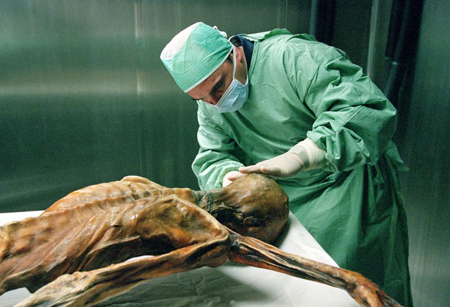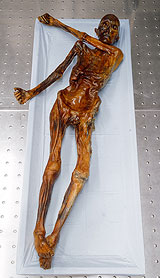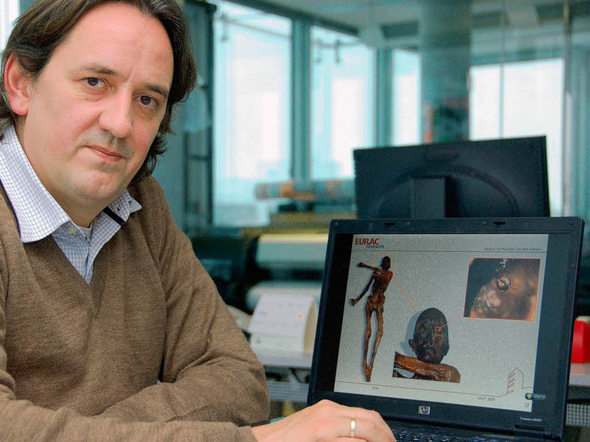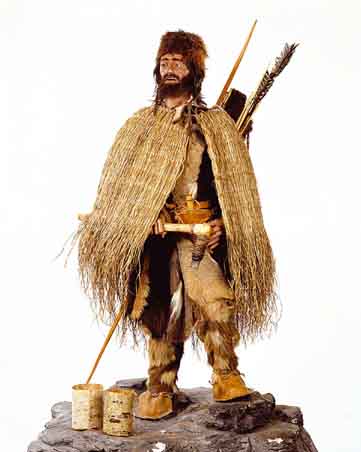Otzi aka Oetzi the Iceman
DNA genetic mapping
decoding sequencing genome studies

Image Credit: The South Tyrol Museum of Archaeology
 On Tuesday 27 July, 2010, scientists attached to
the Institute for Mummies and the Iceman
at the European Academy Bozen/Bolzano (EURAC), the University of Tubingen and an expert at Febit, a German bioinformatics company
based at Heidelberg, Germany, announced significant progress in studies aimed at decoding or sequencing of the
DNA genome of the world famous Otzi the Iceman mummy. On Tuesday 27 July, 2010, scientists attached to
the Institute for Mummies and the Iceman
at the European Academy Bozen/Bolzano (EURAC), the University of Tubingen and an expert at Febit, a German bioinformatics company
based at Heidelberg, Germany, announced significant progress in studies aimed at decoding or sequencing of the
DNA genome of the world famous Otzi the Iceman mummy.
( The capital Ö in Otzi's name is accented as it is pronounced Oot-zee and often actually spelled as Oetzi ).
Otzi the Iceman is the second high-profile candidate from deep in human history for such a genetic mapping study as
the DNA of the family of Ancient Egypt's King
Tutankhamun was also investigated by scientists interested in the genetic mapping of the DNA of our distant ancestors.
On Thursday, September 19, 1991, at about 1.30 p.m. on a sunny afternoon
Erika and Helmut Simon, from
Nuremberg in Germany, were enjoying a vacation walking
through icy and rock-strewn terrain high up on a mountain overlooking the Ötz valley
in the Alpine
borderlands between Austria and Italy when they discovered
human remains protruding out of melting glacial ice.
 The Simons took this picture of their find and returned to their lodgings intending to take steps to inform
the authorities of their discovery. The Simons took this picture of their find and returned to their lodgings intending to take steps to inform
the authorities of their discovery.
Some state employees, a policeman and a mountain rescue officer, accessed the high mountain location,
(3210 metres above sea level!), where the body had been
discovered and began to recover what they presumed to be another of the fallen climbers or mountain walkers that
had unfortunately died whilst pursuing their hobbies in relatively recent times and had been claimed by ice and snow
before being discovered during thaws in later years by other people who had been enjoying leisure times in the high Alps.
Some of the objects recovered with this particular body, however, seemed very ancient leading to consultations with a
local archaeologist and to the eventual realisation that this particular body dated to some 5300 years ago.
Due to the realisation that what was to becoming known as the - Otzi the Iceman - discovery
was bound to be
of immense
scientific and archaeological importance, with some potential for boosting tourism no doubt, there was a dispute between
Italian and Austrian authorities as to who could lay claim to Otzi the Iceman's remains.
Although Otzi was originally taken under Austrian investigative control it was eventually accepted that, as the find spot was actually
just 93 metres
inside
the Italian frontier, it should be that the Italian
claim to physical possession should be accepted.
The Iceman was examined from 1991 to 1998 by experts at the Faculty of Alpine Prehistory at the Innsbruck University in Austria, and although Italian custody of Otzi was
agreed it was understood that future Austrian scientific input would be welcomed.
 The remains of Otzi the Iceman now lie in a purpose built facility entrusted to the supervision of The South Tyrol Museum of Archaeology
in Bozen / Bolzano in Italy's largely german-speaking autonomous region the Alto Adige - Sud Tirol - South Tyrol
where they are stored in a nitrogen rich atmosphere under conditions of controlled temperature and humidity
for their preservation against decay and damaging moulds but can be
seen through a viewing window by interested visitors. The remains of Otzi the Iceman now lie in a purpose built facility entrusted to the supervision of The South Tyrol Museum of Archaeology
in Bozen / Bolzano in Italy's largely german-speaking autonomous region the Alto Adige - Sud Tirol - South Tyrol
where they are stored in a nitrogen rich atmosphere under conditions of controlled temperature and humidity
for their preservation against decay and damaging moulds but can be
seen through a viewing window by interested visitors.
In conducting this genetic mapping study of the DNA of Otzi the Iceman the research team hope that they may be able to better
understand the connection between 5,000-year-old diseases and modern ones.
Their decoding of Otzi's genome is based on a bone sample, of about 1.4 cm long and 1.5 mm in diameter,
that had been extracted with a biopsy needle from the pelvis of the mummy.
The researchers have found Otzi's DNA to be somewhat
damaged after 5300 years.
Nevertheless using the revolutionary SOLiD gene sequencing technology, in association with massive amounts of computer power, they believe they
have achieved a very acceptable standard of genetic mapping in only a few months after recovering the bone sample. The process had been
completed in two to three months when in the past "years" were required for such genome studies.
Carsten Pusch from the Institute of Human Genetics at the University of Tübingen said the team had read about 95 percent of the DNA. The other 5
percent contained no genes and could only be read very poorly with existing technology – a problem that always applies to reading human DNA.

“We are dealing here with old DNA which in addition is heavily fragmented”, explains Albert Zink head of the Institute for Mummies
and the Iceman at the European Academy, (pictured left) who is entrusted
with the care of Otzi.
“It was only by using the very latest technology with its low failure rate that we scientists were able to decode Otzi’s DNA in its entirety within this short space of time.”
According to a statement released by EURAC.
"We now have access to the complete genetic profile of this world famous mummy. As a result the path is clear for an imminent
solution to many of the puzzles surrounding the Iceman."
Interestingly scientists previously defrosted the Iceman mummy and sampled DNA from his intestines. Using this genetic material they
were able to investige Otzi maternal ancestry through
examining the mitochondrial DNA, often referred to as mtDNA, which is only transmitted through the female line by mothers to their children.
DNA researchers classify genetic groups into so-called haplogroups.
The study of Otzi's mitochondrial DNA showed he belongs to haplogroup K, and more specifically to
subhaplogroup K1, meaning he shares an a common ancestor with at least 8% of modern Europeans.
Prior to this mitochondrial DNA investigation on Otzi the K-1 subhaplogroup had three branches or clusters
(K1a, K1b, and K1c--all found in the modern European population). This study revealed that Otzi belonged to a previously unidentified
cluster (now called K1ö).
"The maternal lineage of the iceman has apparently gone extinct," says Martin Richards, an archaeogenetics professor at the University of Leeds. "It's possible that it could still be there in the Alps somewhere" among modern Europeans. "But, if so, it's very rare and has not spread any farther than that."
Otzi may however have been a father but any such descendants would themselves only inherit mitochondrial DNA from their own maternal lineage.
"From comparisons based on the mitochondrial DNA we weren't able to find any relatives in the region. But with the entire genome, there's a good chance we might," said Dr Zink.
"We're at the start of a big and very exciting project. I think Otzi is going to provide us with a lot of information."
 Whilst the research team are still interpreting their own more extensive genetic mapping data, they expect to announce their results in 2011 – to coincide with
the 20th anniversary of the Otzi the Iceman discovery. Whilst the research team are still interpreting their own more extensive genetic mapping data, they expect to announce their results in 2011 – to coincide with
the 20th anniversary of the Otzi the Iceman discovery.
It may be that their discoveries will lead to assertions as to likely hair colour
or eye colour, (Otzi's eyes were seemingly blue - according to an assertion attributed to Carsten Pusch in a German newspaper ), which will influence
attempts at a true reconstruction of the physique of Otzi the Iceman to supplement the previously more reliable evidence as to the clothing and artifacts used by
this uniquely preserved copper age man who emerged out of a glacial deep freeze in 1991.
According to an Otzi the Iceman genetic mapping related page entitled - Otzi’s secrets about to be revealed -
as it appeared on the EURAC website in late July, 2010:-
The most exciting part of their work is yet to come. The scientists are about to process the enormous quantity of bio-data now available to them which should contain the answers to a great many questions. Are any of Otzi’s descendants still around today and if so, where might they be found? Can any genetic mutations be observed between earlier and present day populations? What conclusions about today’s genetic diseases and other prevalent illnesses such as diabetes or cancer can be drawn from the examination of Otzi’s genetic make-up, and his predisposition to various types of ailments? What benefits can be derived from these findings for our own study of genetic medicine? Next year, we shall celebrate the 20th anniversary of Otzi’s discovery. The scientists will mark this occasion by presenting their data analysis as well as the resulting conclusions. We are eagerly awaiting this event.
With Otzi's complete genetic map for their perusal, Dr Albert Zink, the director of the Iceman Institute in Bolzano, and his colleagues have said it might also be possible to shed light
on hereditary aspects of diseases such as diabetes, hypertension and cancer. According to Dr Albert Zink "there are key gene mutations that we know are associated with
diseases such as cancer and
diabetes and we want to see if Otzi had them or whether they arose more recently".
|
|
![[Otzi Oetzi the Iceman DNA genetic mapping]](archaeologist.gif)
![[Otzi Oetzi the Iceman DNA genetic mapping]](archaeologist.gif)